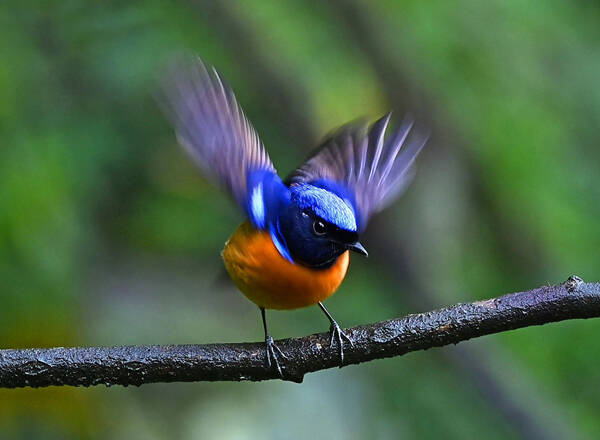Niltava davidi
IUCN
LCBasic Information
Scientific classification
- name:Niltava davidi
- Scientific Name:Niltava davidi,Fujian Niltava,Fujian Flycatcher
- Outline:Songbird
- Family:Passeriformes Flycatcher
Vital signs
- length:15-17cm
- Weight:24-28g
- lifetime:No verification information
Feature
A small, brightly colored flycatcher.
Distribution and Habitat
Distributed in Cambodia, Lao People's Democratic Republic, Thailand, Vietnam.
In China, it is in Sichuan, Guizhou, Yunnan, Fujian, Hong Kong, Hainan Island and Guangxi.
It mainly inhabits mountain evergreen broad-leaved forests, deciduous broad-leaved forests and mixed forests, and also inhabits forest edge sparse forests and shrubs. In summer, it inhabits at a higher altitude, generally in evergreen and deciduous broad-leaved forests and mixed forests rich in understory plants at 900-2200 meters. In winter, it inhabits at a lower altitude and is mostly active at the foot of low mountains. Sometimes it also moves in small bushes near farmlands and villages.
Appearance
The male brown-bellied Great Flycatcher has black forehead, front eyes and sides of the head. The upper coverts from the top of the head to the back of the neck, waist, tail, and the small and middle coverts on the wings are all brilliant cobalt blue or dark blue, with a brighter light cobalt blue spot on the side of the neck. The dark purple-blue large coverts on the back, shoulders and wings look a bit like black, and the flight feathers are dark brown or black, with dark purple-blue feather edges. The central pair of tail feathers are cobalt blue, and the rest of the tail feathers are black, with cobalt blue feather edges on the outer vanes. The chin and throat are black with a dark blue luster, and the chest, abdomen and other lower body are orange-brown or orange-chestnut. The black throat and chest are connected straightly. The female bird has olive brown or olive brown upper body, the back of the head and the blue-gray brown nape, the forehead is light brown, and the front of th
Details
The foreign name of the brown-bellied great flycatcher is Fujian Niltava, and there is no subspecies.

The brown-bellied great flycatcher often moves alone or in pairs, and has the habit of running along thick branches. It is relatively quiet, often quietly resting on shrubs or young branches. When it finds insects on the ground, it suddenly flies to the ground to prey, and sometimes flies into the air to prey on flying insects. The call is a very high-pitched ssssew or siiii sound, which is repeated after a short pause. The alarm call is a sharp metallic sound tit tit tit…trrt trrt trrt…trrt trrt tit tit….
The Rufous Flycatcher mainly feeds on insects such as beetles, ants, moths, mosquitoes, gnats, bees, crickets, etc., and also eats a small amount of plant fruits and seeds.
The breeding season of the Rufous Flycatcher is from May to July. It usually nests in caves on steep rock slopes or between rocks, and also in natural tree holes. The nest is cup-shaped, mainly composed of moss, with fine fibrous roots inside. Each nest usually lays 4 eggs, which are light yellow or yellowish, with pink-brown or light red spots, especially dense at the blunt end, often forming a ring at the blunt end. The size of the egg is 16-19 mm × 12.9-14.2 mm. The female bird is mainly responsible for incubation, and the male bird occasionally participates in the incubation activities. The chicks are late-maturing, with an incubation period of 12-13 days, and the male and female parents raise the chicks together.
Listed in the "Red List of Threatened Species of the World Conservation Union" (IUCN) 2016 ver 3.1-Least Concern (LC).
Listed in the "National List of Terrestrial Wildlife with Important Economic and Scientific Research Value" issued by the State Forestry Administration on August 1, 2000.
Listed in the second level of the "National List of Key Protected Wildlife in China".
Protect wild animals and eliminate game.
Maintaining ecological balance is everyone's responsibility!








